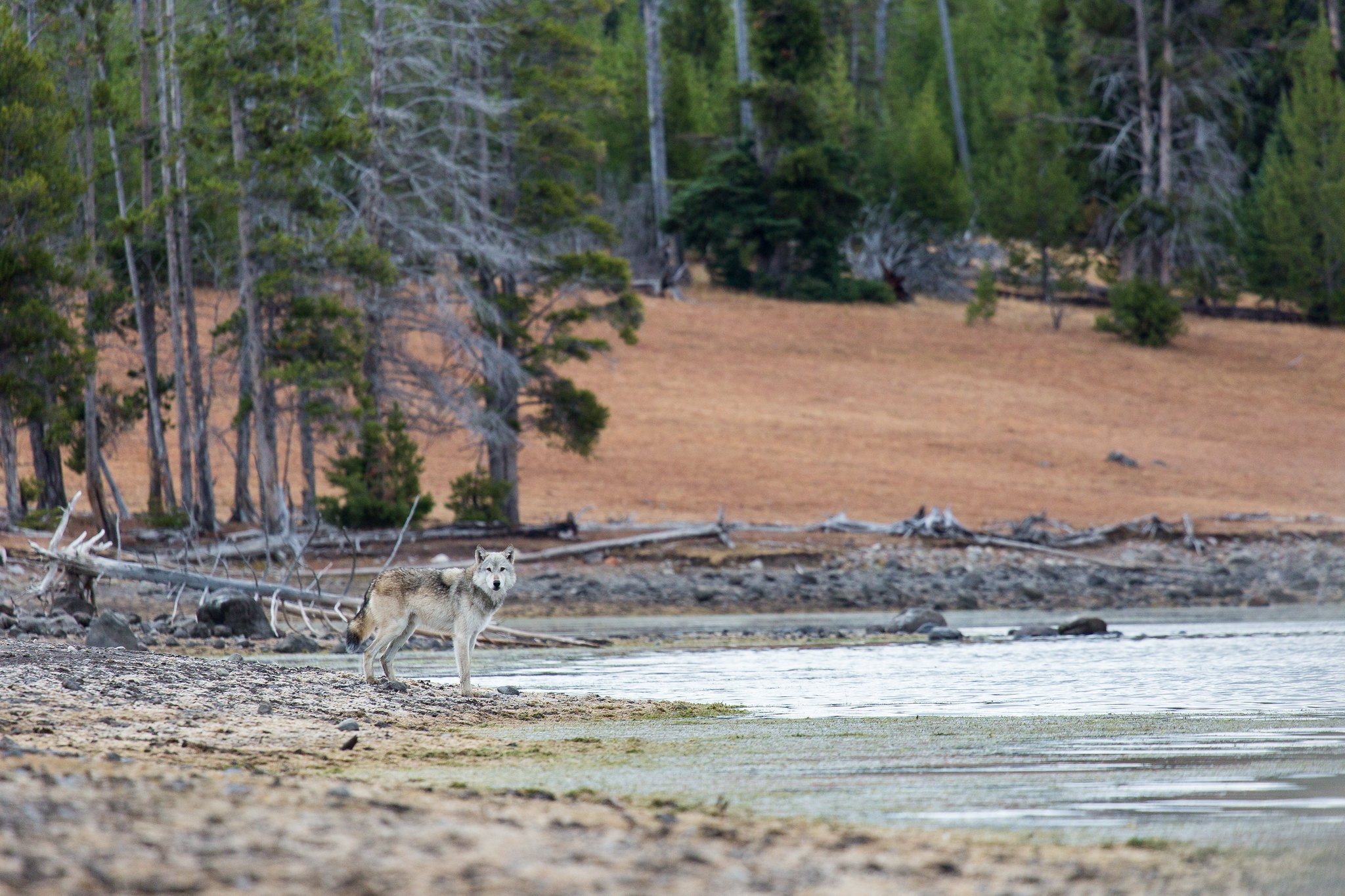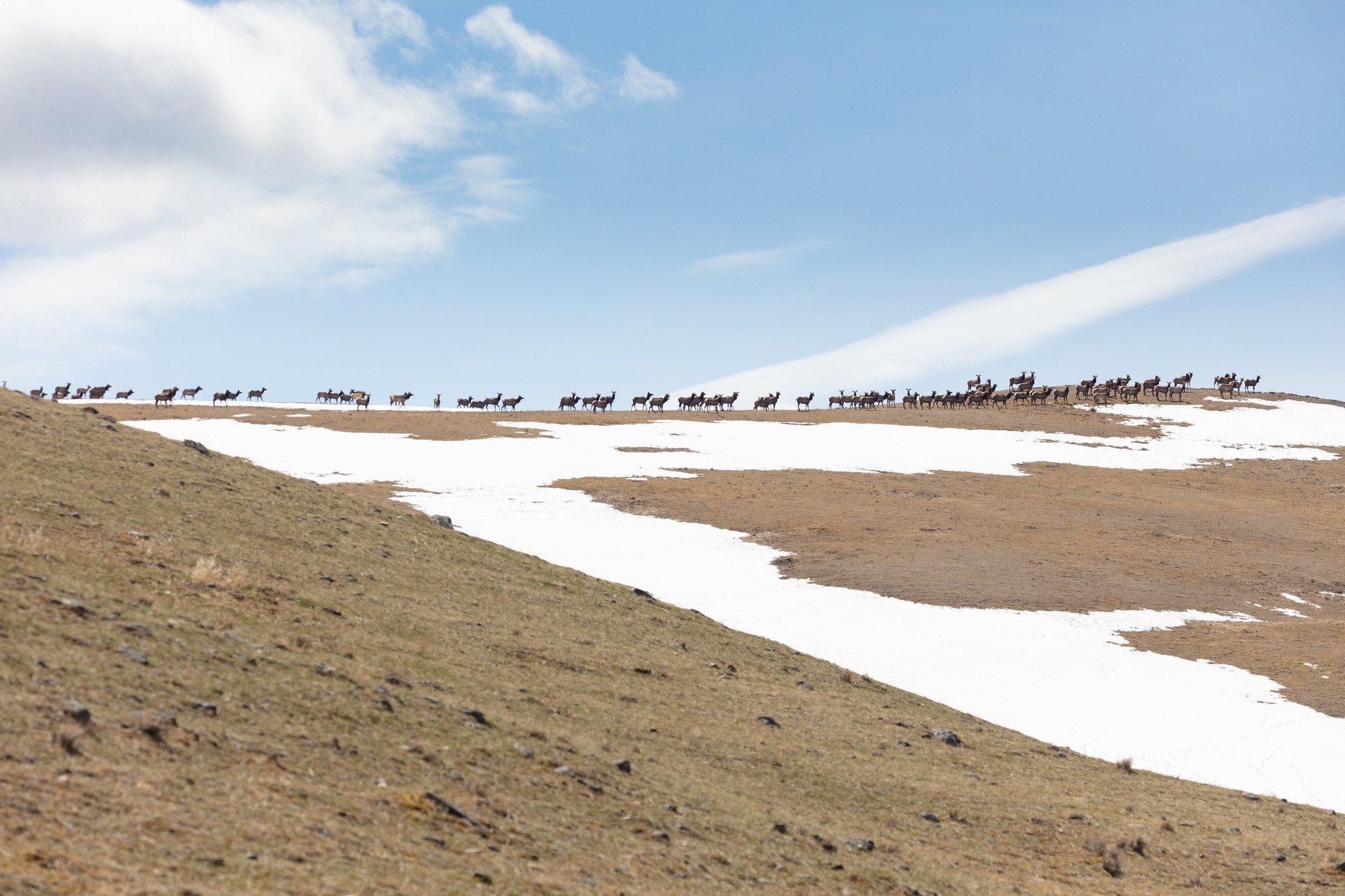GYC celebrates 40 years of protecting Greater Yellowstone
I’ll never forget seeing my first wolf in Yellowstone. It was early evening, and I was driving through the park near Madison Junction. I didn’t see the wolf right away, but noticed elk starting to stand up in the distance and thought, “I wonder why the elk are rising?” And then it appeared...coming up the bank from crossing the river. It shook water off its fur and seemed to have a destination in mind. It was alone and I was filled with excitement and hope; could it be a wolf? I knew I had to wait to find out. Luckily, it continued to trot toward me over the next few minutes and eventually crossed the road right in front of me. There it was: a lone Yellowstone wolf. I was filled with excitement and appreciation for those who came before me and helped return wolves to the world’s first national park.
A wolf on the shore of Yellowstone Lake in Yellowstone National Park. (Photo NPS/Neal Herbert)
A few years later, after spending time with some GYC donors in Silvergate, Montana near the Northeast Entrance of Yellowstone, our executive director and I were heading home at dusk. Just as we approached the east side of Lamar Valley, a grizzly sow and two cubs meandered through the sagebrush and allowed us to photograph them. We stopped the vehicle and watched them until it was too dark to see. As they were foraging for food, we were awestruck by this magnificent mother who continued to watch and care for her young while also ensuring they were getting the nutrients and skills they needed to survive and thrive. We knew this was another reminder that we were extremely lucky to be working for an organization that helped bring this remarkable species back from the brink of extinction.
A few years later near my home in Montana between Bozeman and Ennis, I witnessed an enormous herd of mighty elk run across Highway 287 heading west toward Yellowstone. It was a sight to behold. The sound of their hooves running in unison and their movements so eloquent, even while jumping a fence, has been imprinted on my brain forever. I had never seen such large numbers – we estimated 1,000 animals – and it was again a reminder of the magnificence of Greater Yellowstone’s wide-open landscape and amazing wildlife. It is a place to behold.
A group of elk move along a ridge in Yellowstone National Park. (Photo NPS/Jacob W. Frank)
These moments, among many others over the years, make telling the story of our work easy. I am constantly inspired by this remarkable place and the people who work to secure wildlife habitat, protect wild rivers, and maintain open landscapes. I bet you, too, have your magical memories from Greater Yellowstone – your first road trip to Yellowstone as a kid, the first time you saw the Tetons when you came over Togwotee Pass, the look of awe on your kids' faces when they saw their first grizzly, wolf, or elk. These are memories we never forget, and memories that inspire us even when we're thousands of miles away.
As staff, we are committed to this work because we know it is up to us – all of us and you too – to do what we can to protect and conserve this special place called the Greater Yellowstone Ecosystem. I have met many amazing people during my tenure, and I am honored to reflect on our work not only during my time at the Greater Yellowstone Coalition, but long before.
In the early days, one of our founders, Rick Reese, remembered how the organization began and wrote, “Momentum was building for the creation of an organization to advocate for the Greater Yellowstone Ecosystem. The concept was now fairly well understood and generally accepted by interested conservationists. But now a new set of skills, contacts, and experience were becoming especially important. Fortunately, some very bright, motivated, and highly skilled people were beginning to bring such assets to the table.”
By 1983, a group of dedicated conservationists, activists, scientists, and others who cared deeply about this special place – many of whom I have met and learned from over the years – came together at Mammoth for a founding convention. Eventually, the Greater Yellowstone Coalition was formed and so began GYC’s 40-year legacy.
In the 1990s, our work focused primarily on grizzly bear conservation, land trades to limit development, reintroducing wolves into Yellowstone, giving bison more room to roam, and halting the New World Mine. Our New World Mine campaign brought President Clinton to Yellowstone where he declared, “Yellowstone is more precious than gold.”
In the 2000s, we helped ban energy development on critical wildlife habitat in the Bridger-Teton and Shoshone national forests and assisted in passing the Craig Thomas Snake Headwaters Legacy Act, which protected 387 river miles along 13 pristine streams in Wyoming.
During the next decade, we helped secure 360,000 acres of habitat for bison outside Yellowstone National Park, advocated for better wildlife policy for grizzly bears and wolves, and built support for river protection under the Wild & Scenic Rivers Act.
Over the past decade, we have bearproofed more than 100 national forest campgrounds, helped pass both the Yellowstone Gateway Protection Act and East Rosebud Wild and Scenic Rivers Act, advocated for and supported the construction of 23 wildlife crossing structures or projects, secured funds to expand the Yellowstone Bison Conservation Transfer Program, protected more than 500,000 acres of habitat for grizzly bears, and hosted the Wind River Inter-Tribal Gathering to foster increased Indigenous input and participation in the management of public lands.
(L-R) Grand Teton superintendent Chip Jenkins, environmental scientist Robyn Blackburn, Yellowstone superintendent Cam Sholly, and National Park Service director Charles “Chuck” Sams, III speak on the Tribal-Federal Consultation panel at the Wind River Inter-Tribal Gathering. (Photo GYC/Emmy Reed)
Despite all of these successes, threats to the ecosystem persist. Ever-increasing impacts from climate change like epic floods, habitat fragmentation, increased pressure from more and more people living in and visiting the region, conflicts with wildlife, political polarization and politicians meddling with wildlife management, lack of respect for Indigenous culture and sovereignty, and even proposals for mines all threaten the lands, waters, and wildlife of this special corner of the Earth. These are huge challenges to be sure; however, we know how address them, we cannot give up, and we need your help.
Our legacy of success is due to people like you. Tens of thousands of people have joined us over the years to help protect this remarkable place. Every single person who loves Yellowstone can make a difference, whether you advocate for better policies, inspire others to lend their voice, give a financial gift, sign up to receive our communications, or attend an event. Any one of these actions can make a difference for the lands, waters, wildlife, and Tribes of Greater Yellowstone.
Your participation, no matter the form, helps us persist in protecting Greater Yellowstone and working with the original stewards of these lands, our Native partners. The Apsáalooke/Crow, Arapaho, Bannock, Blackfeet, Cheyenne, Shoshone, and so many more live in reciprocity with nature and retain deep connections to this remarkable place. Indigenous Peoples have endured so many injustices, and we owe it to them to elevate and incorporate their voices now and in the future.
So the next time you experience a special moment in nature, remember the people who have helped make a difference for the place near and dear to you, whether it’s Indigenous Peoples, our founders 40 years ago, or someone who took their first step just yesterday. Then, do something positive for nature – either in your own community or for Greater Yellowstone. People will not forget your kindness because it truly takes all of us to do this work.
—Christi Weber, Director of Communications and Marketing
The Greater Yellowstone Ecosystem is the land of 49+ Indigenous Tribes who maintain current and ancestral connections to the lands, waters, wildlife, plants, and more.




